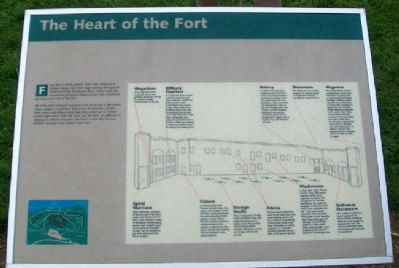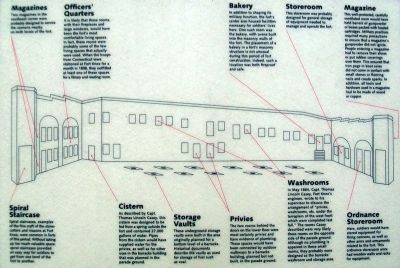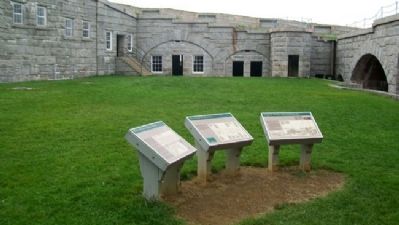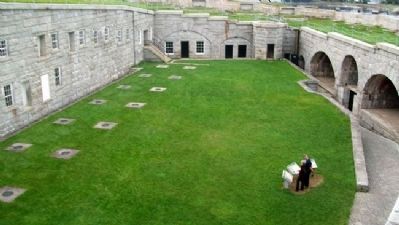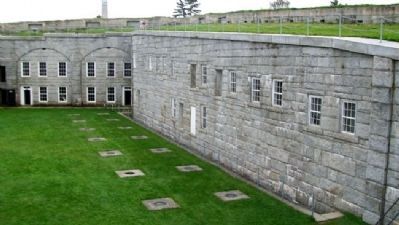Prospect in Waldo County, Maine — The American Northeast (New England)
The Heart of the Fort
Fort Knox's thick granite walls were designed to deflect cannon fire from ships passing through the Narrows of the Penobscot River. These walls also enclosed a pentagon-shaped center that contained the heart and soul of the fort.
All of the fort's essential functions were protected at this center. Here, soldiers would have had access to cannons, cannonballs, guns and related tools that they could use to defend enemy approaches from the river and the land. In addition to shaping its military function, the fort's center also housed facilities necessary for soldiers' lives here.
Magazines
Two magazines in the southeast corner were probably designed to service the cannons nearby on both levels of the fort.
Officers' Quarters
It is likely that these rooms, with their fireplaces and large windows, would have been the fort's most comfortable living spaces. In fact, these rooms were probably some of the few living spaces that actually were used. When the troops from Connecticut were stationed at Fort Knox for a month in 1898, they outfitted at least one of these spaces for a library and reading room.
Spiral Staircase
Spiral staircases, examples of the fine craft of the stonecutters and masons at Fort Knox, were common in forts of this period. Without taking up too much valuable space, spiral staircases provided an easy way for soldiers to get from one level of the fort to another.
Cistern
As described by Capt. Thomas Lincoln Casey, this cistern was designed to be fed from a spring outside the fort and contained 27,000 gallons of water. Pipes from the cistern would have supplied water for the privies, as well as for other uses in the barracks building that was planned in the parade ground.
Storage Vaults
These underground storage vaults were built in the area originally planned for a bottom level of a barracks. Historical documents describe the vaults as used for storage of fuel such as coal.
Privies
The two rooms behind the doors on the lower floor were most certainly privies and have evidence of plumbing. These spaces would have been connected by outdoor walkways to a barracks building, planned but not built, in the parade ground.
Washrooms
In May 1864, Capt. Thomas Lincoln Casey, Fort Knox's engineer, wrote to his supervisor to discuss the arrangement of "privies, washrooms, etc. under the terreplein of the west front which were completed last fall." The rooms Casey described were very likely these rooms on the opposite side of the parade ground. Although no plumbing is apparent in these small rooms, they probably were designed as the barracks' washroom and storage area.
Ordnance Storeroom
Here, soldiers would have stored equipment for firing cannons, as well as other arms and armaments related to the fort. This ordnance storeroom once had wooden walls and racks for equipment.
Bakery
In addition to shaping its military function, the fort's center also housed facilities necessary for soldiers' lives here. One such room was the bakery, with ovens built into the masonry walls of the fort. The placement of a bakery in a fort's masonry structure is not unusual during this period of fort constructino. Indeed, such a location was both fireproof and safe.
Storeroom
This storeroom was probably designed for general storage of equipment needed to manage and operate the fort.
Magazine
This well-protected, carefully ventilated room would have held barrels of gunpowder or boxes packed with loaded cartridges. Military practices required many precautions to ensure that a magazine's gunpowder did not ignite. People entering a magazine had to remove their shoes or put rubber coverings over them. This ensured that iron pegs in boot soles did not come in contact with small stones or flooring nails and create sparks. In addition, all tools and hardware used in a magazine had to be made of wood or copper.
Erected by Maine Department
of Conservation.
Topics. This historical marker is listed in this topic list: Forts and Castles. A significant historical month for this entry is May 1864.
Location. 44° 33.965′ N, 68° 48.14′ W. Marker is in Prospect, Maine, in Waldo County. Marker is on the Parade Ground inside the fort, at Fort Knox State Historic Site. Touch for map. Marker is at or near this postal address: 711 Fort Knox Road (Maine Route 174), Stockton Springs ME 04981, United States of America. Touch for directions.
Other nearby markers. At least 8 other markers are within walking distance of this marker. Where Did the Soldiers Sleep? (here, next to this marker); Digging Down and Building Up (here, next to this marker); The Casemate - Key to Fort Design (a few steps from this marker); Firing a Cannon (a few steps from this marker); Fort Knox (within shouting distance of this marker); Terreplein (within shouting distance of this marker); A Grand Plan (within shouting distance of this marker); A Question of Boundaries (within shouting distance of this marker). Touch for a list and map of all markers in Prospect.
Also see . . . Fort Knox State Historic Site, Maine. (Submitted on May 10, 2012, by William Fischer, Jr. of Scranton, Pennsylvania.)
Credits. This page was last revised on September 23, 2020. It was originally submitted on May 10, 2012, by William Fischer, Jr. of Scranton, Pennsylvania. This page has been viewed 569 times since then and 4 times this year. Photos: 1, 2, 3. submitted on May 10, 2012, by William Fischer, Jr. of Scranton, Pennsylvania. 4, 5. submitted on May 13, 2012, by William Fischer, Jr. of Scranton, Pennsylvania.
